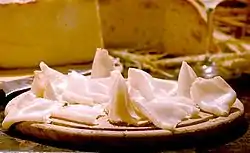Lardo
Lardo is a type of salumi made by curing strips of fatback with rosemary and other herbs and spices.[1]
.jpg.webp)

The most famous lardo is from the Tuscan hamlet of Colonnata, where lardo has been made since Roman times. Colonnata is a frazione of the larger city of Carrara, which is famous for its marble; Colonnata is itself a site where Carrara marble is quarried and, traditionally, lardo is cured for months in basins made of this marble. Lardo di Colonnata is now included in the Ark of Taste catalog of heritage foods as well as enjoying IGP (Protected Geographical Indication) status since 2004.[2] It is composed of over 90% lipids.[3]
Another prized form of lardo is the Valle d'Aosta Lard d'Arnad, a PDO product from the area of Arnad in Aosta Valley of northwest Italy. Both superior types of lardo may be served very thinly sliced as an antipasto.
See also
- Salo (food), a similar Slavic food
References
- Gold, Jonathan (2007-07-25). "Slab City: On the meat trail, a lardo dream". LA Weekly. Retrieved 2007-08-04.
- "Lardo di Colonnata". Tuscanjourney.org. Archived from the original on June 17, 2008. Retrieved 29 October 2011.
- R Nuvoloni; A Nannipieri; E Purini; F Pedonese; B Turchi; B Torracca; O Benini (August 2, 2012). "Characterisation of PGI lardo di Colonnata" (PDF). Italian Journal of Food Safety. 1 (4): 81–85. doi:10.4081/ijfs.2012.4.81. ISSN 2239-7132. OCLC 4951289742. Archived from the original on April 28, 2016 – via DOAJ.
{{cite journal}}: External link in|via=
